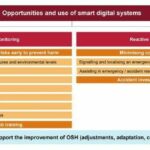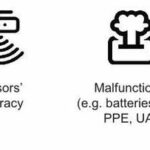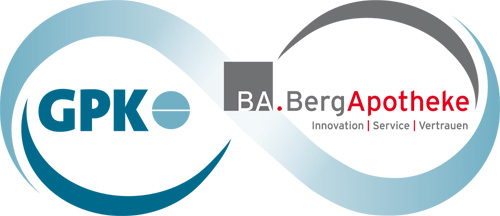1 Introduction
This summary report identifies the types, purposes and uses of smart digital monitoring systems for occupational safety and health (OSH).1 It also assesses the opportunities, challenges and risks of these systems and provides recommendations for policy, research and practice for the purpose of improving workers’ OSH. The summary report is based on a longer piece of EU-OSHA’s work using as a reference 180 sources, data from the Third European Survey of Enterprises on New and Emerging Risks (ESENER-3) and online interviews with 29 key informants.2
The study is structured as follows:
Section 2 focuses on the drivers and barriers of the adoption of smart digital monitoring systems at the workplace.
Section 3 provides a working definition of smart digital monitoring systems and distinguishes between proactive and reactive ones.
Section 4 discusses the opportunities of using smart digital monitoring systems at the workplace.
Section 5 discusses the challenges and risks of smart digital monitoring systems for workers’ OSH with particular reference to physical and psychosocial health risks. The section also adds some broader considerations on the implications of these systems for workplaces.
Section 6 proposes some responses to the challenges and risks of smart digital monitoring systems.
Section 7 presents the conclusions of the study and provides recommendations for policy, research and companies.
2 Drivers, barriers and uptake
2.1 Overview of drivers and barriers to adoption
Smart digital monitoring systems can help to improve OSH. However, there are (1) technology, (2) legislation, standardisation and research, and (3) organisational factors that are influencing their adoption at workplaces.
Technological push
The development of technologies such as artificial intelligence (AI) and the Internet of things (IoT) is increasing the capabilities of smart digital monitoring systems and making them more accessible to companies. However, challenges such as reliability, customisation, size, as well as development and standardisation costs remain.
Legislation, standardisation and research
In terms of legislation, EU legislation has some open issues as EU Directive 89/391/EEC does not explicitly address the new challenges of digital technologies used in smart digital monitoring systems. Open issues remain also in relation to certification standards that can often be complex, and result in high costs. Last, in terms of research, obtaining robust hard data on the effectiveness of digital smart systems is challenging.
Organisational factors
Organisational factors can serve both as a driver and barrier in relation to the adoption of smart digital monitoring systems.
On the one hand, ensuring compliance and reducing insurance costs as well as improving the wellbeing of an ageing workforce can be a driver for the adoption of smart digital monitoring systems. On the other hand, concerns around using smart digital monitoring systems as a pretext for employee surveillance and performance measurement as well as issues related to data can serve as a barrier. An additional barrier can be the perceived financial and time resources of companies in terms of integrating smart digital system into their existing OSH management system.
2.2 Trends in uptake
Although there is no hard evidence, product manufacturers interviewed for this study pointed to an increasing demand for smart digital monitoring systems particularly from large, and often cross-border, companies in high OSH risk sectors.
3 Taxonomy of Smart digital monitoring systems across the OSH cycle
3.1 Definition
This study defines smart digital monitoring systems as those using digital technology to collect and analyse data in order to identify and assess risks, prevent and/or minimise harm, and promote occupational safety and health. This definition seeks to address the advantages and disadvantages of existing definitions and strike a balance between breadth and depth. More information behind the rationale of this definition is available at the main report.
3.2 Digital technologies
Smart digital monitoring systems use conventional but also new digital technologies.3 In practice, these technologies are often embedded into PPE, wearables and equipment that transmit data to a cloud-based platform.
Types of risks monitored
Smart digital monitoring systems monitor a wide cast of OSH risks (chemical, ergonomic, psychosocial, physical, safety-related risks). These risks relate to the so-called 4Ps: plant, premises, people and procedures and they can differ from sector to sector but also within companies in the same sector.
Types of data collection
Smart digital monitoring systems can collect real-time data about the working environment / equipment, individual workers or both. GDPR, prior consultation with trade unions and non-use of personal identifiers can help address issues around the collection of personal data, albeit these warrant careful consideration.
Types of needs addressed
Smart digital monitoring systems can often address the specific needs of specific groups of workers (e.g. lone workers, workers with disabilities such as hearing impairments, ageing workforce). Therefore, they may support inclusion at the workplace. At the same time, they are also relevant for emerging needs in the context of COVID-19 and teleworking.
3.3 Taxonomy
This summary report based on the purposes of smart digital monitoring systems distinguishes between proactive and reactive ones. This taxonomy should not be seen as clear-cut, as, in practice, smart digital monitoring systems can combine both properties. More information behind the rationale of the taxonomy is available in the main report of this study.
4 Opportunities and use of smart digital monitoring systems
This section summarises the opportunities of smart digital monitoring systems based on the developed taxonomy. An overview of how the section is organised is shown in Figure 1.
4.1 Proactive OSH monitoring
Proactive OSH monitoring has two main purposes: first, identifying and assessing risks early on, to prevent harm (section 4.1.1); second, providing training to workers4 (section 4.1.2);
4.1.1 Identifying hazards and assessing risks early to prevent harm
Measuring individual / collective harmful exposures and environmental levels
Proactive smart digital monitoring systems can collect real time data on workers’ exposure to different types of risks e.g., chemical, ergonomic, psychosocial, physical, and safety-related risks.
For example, such systems can monitor exposure to mercury for workers in the petrochemical sector and UV radiation for workers in outdoor construction or in the agriculture sector and prevent risks such as skin cancer. In addition, they can also measure temperature and prevent heat-related risks (e.g., in firefighting).
Smart digital monitoring systems can also send warning signals to workers when exposure levels might compromise their health. Examples include systems alerting workers to correct dangerous postures (e.g. in warehouse facilities), to be cautious of vibration levels when using certain equipment (e.g. in outdoor construction), etc. On some occasions, systems using geofencing can also warn workers to steer clear off dangerous areas and machines (e.g. in mining) or trace sources of contamination.
In terms of monitoring environments, systems using wireless sensor networks (WSNs) are increasingly used to perform remote monitoring of poisonous dust, chemicals, explosive gases and others in mining and tunnel construction work, among other sectors. In turn, UAS such as drones can pick up samples and detect methane leaks in industrial settings or sectors such as precision agriculture. Finally, technologies such as AR can provide data on hidden risks such as asbestos.
Measuring exposure to ergonomic risks
Smart digital monitoring systems can also measure exposure to ergonomic risks and prevent work-related musculoskeletal disorders (MSDs) such as repetitive strain injuries.
For example, smart digital monitoring systems using accelerometer sensors can track unsafe or harmful movement and prevent the accumulation of physical strain. These systems can send aggregate data to OSH managers to help them design measures eliminating or reducing exposure to risk factors e.g. through hanging the layout of a production line.
These systems are also able to provide direct feedback to workers, for example, by means of vibration, audio or visual data, and offer them tailor-made training based on their characteristics such as age, weight, height etc. In this context, it is worth noting the use of exoskeletons in helping workers manage MSDs. For example, active exoskeletons can reduce physical strain (e.g. spinal, muscular, bone, ligament) and enhance the physical capabilities of workers, while passive exoskeletons can redistribute physical effort to protect specific parts of the body. Last, but not least, collaborative robots that are interconnected with workers’ equipment can also improve OSH monitoring of MSDs.
Identifying plant and premises-related risks
A number of smart digital monitoring systems are able to identify plant and premises-related risks that can relate to slips, trips, falls, site traffic and others. For example, systems RFID and cameras can track the location and speed of industrial vehicles, and activate emergency stop buttons when this exceeds safety thresholds. Systems such as smart active protective trousers can also have a stop function for chainsaws that are getting too close to the worker. Finally UAS and autonomous robots can also monitor and identify plant and premises-related risks.
Identifying hazardous worker behaviour
Another opportunity of smart digital monitoring systems is tracking or even predicting unsafe behaviour such as speeding industrial vehicles or checking compliance with safety requirements. For example, technologies such as RFID or deep learning can check whether workers are wearing safety equipment, such as respiratory masks and restrict their access to specific areas. Similar systems can also check whether maintenance of such equipment has been performed as scheduled and thus help an OSH manager decide whether a task using this equipment is to be performed or not. In offshore industries, these systems are often interconnected with other process safety systems aiming to improve OSH.
Sometimes, unsafe worker behaviour is linked to workers’ fatigue or stress. Here, smart digital monitoring systems such as wearables can detect signs of physical or mental fatigue that can impair decision-making and predict through ML algorithms when and where accidents are more likely to occur (e.g. specific points in time where truck drivers are more prone to accidents). At the workplace level, these insights are very important as they can generate disaggregated fatigue scores by shifts and locations which can be used to improve OSH through structural measures.
Identifying poor individual health and wellbeing
Smart digital monitoring systems using wireless tech can track individual workers’ physical and mental wellbeing. Examples include mobile applications monitoring heart rate, blood pressure, sleep patterns, shift work and so on. These applications and systems are increasingly affordable and can also nudge positive behaviours through gamification. In this context, it is also possible to monitor behaviour outside work (e.g. sleep deprivation) that can have an impact on work (e.g. accident). However, this option is not without its problems as it blurs the boundaries between work- and private-life.
Psychosocial and organisational opportunities
Smart digital monitoring systems can also bring a few but important opportunities in relation to the psychosocial health of workers and the organisation of work.
For example, when these systems are used by companies to implement structural changes such as changing the layout of a workplace to prevent injuries, improving task and shift allocation, providing individualised training and so on, they can help workers to manage psychosocial risks as well as feel safer and more productive. In addition, when systems such as UAS, AR, WSNs and cobots can remove workers from dangerous tasks such as monitoring / doing maintenance work on an industrial plant, they can decrease occupational stress and its toll on mental health and wellbeing. Other examples of opportunities include providing better work-life balance and improving job meaningfulness, motivation and control over decisions through on-the-job training.
Online risk assessments and remote inspections
Another field of opportunities when it comes to smart digital monitoring systems is performing digital risk assessments and inspections faster, easier, safer and more tailored, even remotely. For example, VR makes possible virtual walks in plants while UAS can pick up samples. In turn, ML and big data can help companies make predictions based on past accidents.
4.1.2 Providing on-the-job training
Last, and importantly, many smart digital monitoring systems can provide on-the-job training to workers.
Camera systems combined with AI can help companies analyse accidents and design safe practices. In turn, wearable devices, including PPE, can track unsafe behaviour (e.g. non-ergonomic lifting of a heavy box) and provide tailor-made training to workers (e.g. based on their age, weight, etc.) in the form of e-learning tutorials in a mobile application or in the form of alerting vibrations or sounds.
4.2 Reactive OSH monitoring
Reactive OSH monitoring has two main purposes: first, minimising consequences of accidents / emergencies5 (section 4.2.1); and reporting and investigating accidents (section 4.2.2). These purposes are discussed in detail in the below sections.
4.2.1 Minimising consequences
of harm
Signalling and localising emergencies
Signalling and localising emergencies can help locate fast and accurately workers who might be at serious risk. Examples include smart digital monitoring systems with geotagging, underground Bluetooth, 5G and WSN technologies that can minimise the time of rescue operations, for example, in the case of an accident in underground mining, during a firefighting operation or during construction work (e.g. man-down functions).
On such and similar occasions, smart digital monitoring systems can automatically signal emergencies through, for example, fall detection tech using accelerometers or through sending automatic panic alerts even when the worker is unable to make an emergency call. As workers are located, rescue operations can take less time. Drones also offer vast opportunities in terms of search and rescue in under- or overground operations. For instance, autonomous drones with GPS and RFID can track hazards in underground mining working environments, while there are also drones that can track victims as well as predict new hazardous deflagrations in petrochemicals.
Apart from minimising consequences of risks in high OSH risk sectors, such opportunities are also available for the healthcare sector, albeit less frequently.
Assisting in emergency /
accident response
Smart digital monitoring systems may also assist in emergencies and accidents. Such systems can deliver information (videos, audio, images, text), for example, through smart glasses, to help a worker navigate a difficult situation. In addition, for some specific sectors such as firefighting, they can include features such as automatic / active cooling systems that may save lives or minimise the consequences of harm when other ways of reducing heat strain are not viable.
Apart from the functions shown above, smart digital monitoring systems such as UAS can also track defects in equipment being worn during emergencies and thus minimise consequences of potential harm. On such occasions, UAS are able to also deliver new equipment, for example, breathing apparatus to workers in an emergency case in the mining sector.
4.2.2 Accident investigation and reporting
Smart digital monitoring systems can also help in accident investigation. This includes providing information on where the accident occurred, who was present and who the victims were as well as what actions and/or conditions led to it, and what happened during the accident and the subsequent rescue operations – thus establishing a chain of events.
This chain of events can help companies improve OSH in the future through managing risks that can lead to accidents based on the hierarchy of controls and through improving their rescue operations. In addition, they can help companies establish accurate, data-driven reporting that is easier to access, compared to paper-based reporting. By the same token, as they often collect real-time data, they can address the risk of under-reporting accidents.
5 Risks and challenges of Smart digital monitoring systems
Next to opportunities, smart digital monitoring systems come with a set of risks and challenges. This section identifies challenges and risks pertaining to physical health and safety, psychosocial risks, the risk of blurring OSH responsibility and training.
5.1 Physical health and safety risks
This section presents the risks of smart digital monitoring systems to physical health and safety. Figure 2 provides a summary of these risks.
To begin with, smart digital monitoring systems may have adverse or otherwise unknown negative effects on workers’ safety and health. For example, exoskeletons, through redistributing effort in the body, can result in new risk factors that can lead to MSDs. In addition, they might entail other risks such as increasing cardiovascular load and stress or making workers over-confident in their abilities, which, in turn, can result in accidents.
Moving on, smart digital monitoring systems using sensor tech might not accurately collect data in industrial settings as these differ from lab conditions, where these sensors are tested and certified. This can result in the danger of exposing workers to higher OSH thresholds than those acceptable or having AI-powered decision-making systems rely on such data. In addition, the sensors of these systems often have limitations. To illustrate the point, drones using thermal cameras might not be able to distinguish workers from their surroundings. These conditions highlight the need for companies to maintain their OSH competences and avoid overreliance on such systems.
Another challenge is that new technologies or their electronic components can malfunction. For example, batteries might not be able to function under specific environmental conditions, while on some occasions, they can overheat or explode. In a similar example, if water penetrates a sensor-based vest’s electrical parts, it might cause short circuits and electric shocks.
Last, but not least, the misuse of smart digital monitoring systems might compromise the health of the workers either through intensifying work or de-intensifying work. For example, in the latter case, removing workers from tasks such as manual handling might reduce their overall physical fitness, which can lead to loss of muscle / bone density or joint flexibility.
5.2 Psychosocial risks
This section turns to the psychosocial risks of smart digital monitoring systems. Figure 3 presents those risks, which refer mainly to electronic performance measurement (EPM) and can be used as a proxy for smart digital monitoring systems.
On top of the above, questions around data privacy, ownership and security, and whether monitoring is used as a pretext for digital surveillance, performance measurement, workplace discrimination and algorithmic management, remain. The main report of this study provides a detailed account of how these issues can affect psychosocial health, especially in relation to vulnerable or otherwise disadvantaged workers.
5.3 Responsibility and
OSH monitoring systems
Another risk of smart digital monitoring systems is one where employers use these systems as a substitute for putting in place a robust OSH framework based on the hierarchy of controls or, at worst, as a pretext to reduce resources to train workers and to shift responsibility from collective to individual control measures. The above developments are likely to have negative implications on workers’ health, since there is strong evidence suggesting that smart digital monitoring systems in themselves are not the solution to OSH but rather a – sometimes residual – part of the solution to OSH.
6 Stages of risks and challenges, and measures to mitigate / overcome them
6.1 Technological maturity
As shown earlier, there are several risks in relation to the technological advancement of the technologies used in smart digital monitoring systems. Some of the main issues appear to be related to standardisation, sensors’ accuracy and processing capabilities, as well as data interpretation. However, these issues are not found in all of the technologies and their applications across sectors and job tasks. Nonetheless, it is important in all cases to train workers on how they can interact with new technologies and provide them with clear steering in terms of their purposes and limits, also through workplace resources.
6.2 Design and implementation
A response to potential challenges of smart digital monitoring systems is the application of human-centred design. This is better done at the design stage, compared to the deployment stage, when the new OSH monitoring system is off the shelf. Another response is opting for systems that are configurable to specific workplaces and their needs instead of one-size fits all solutions. Finally, involving works councils can also be an effective response in terms of gaining workers’ buy-in and trust in these systems and addressing critical questions surrounding the use of data.
7 Conclusion
This summary report provided a working definition of smart digital monitoring systems and then assessed their uses, opportunities and challenges using a taxonomy distinguishing between proactive and reactive systems. The summary report maintains the while smart digital monitoring systems have the potential to improve OSH there are aspects around their use which warrant careful considerations.
To tap in the potential of smart digital monitoring systems, the report concludes with a set of recommendations for policy, research and at the workplace level.
At the policy-level, it can be useful to:
- Consider the impact of smart digital monitoring systems on workers’ rights, working conditions and OSH
- Ensure that legal and policy frameworks regulating these areas keep pace with the fast development of digital tools and the implications of their use at the workplace.
- Situate smart digital monitoring systems within the hierarchy of controls and delineate roles and responsibilities of employers and workers.
- Focus legislation, regulation and issues around liability on facilitating innovation without stalling technological advancement.
- Ensure adequate standardisation that supports product quality and safety, and the creation of markets.
- Bring together employers, employee representatives and occupational physicians and reach collective agreements on how smart digital monitoring systems are to be used at the workplace.
At the research-level, it can be useful to:
- Fill the research gap with regard to OSH risks that smart digital monitoring systems can have.
- Carry out research at workplace level to understand what happens in practice across companies in different sectors in order to assess the extent and the ways in which smart digital monitoring systems can promote OSH.
- Focus on research that provides robust data on the effectiveness of OSH monitoring systems, with attention devoted to specific needs and workers.
- Better disseminate research to make information on smart digital systems more accessible to employers
At the workplace level, it can be useful to:
- Consider from the early design stage the positive and negative impacts of the adoption of smart digital monitoring systems
- Be clear regarding ‘information ecology’ (how the data is used, who can access it and who owns it) and ensure robust data security.
- Ensure that the design and implementation of smart digital monitoring systems respect the ‘human in control’ principle.
- Ensure workers and worker representatives’ participation in the design and implementation of the systems.
- Ensure that new systems have a positive impact not only in terms of physical health and safety but also with regard to mental health and wellbeing.
- Conceive smart digital monitoring systems as tools to improve and promote OSH through workplace adaptations, adjustments, corrective measures, worker training, and a reinforced culture of trust and participation – rather than ends in themselves. In other words, to conceive smart digital monitoring systems as part of the solution, but not the solution itself.
1 Hereinafter also referred as „smart digital monitoring systems“.
2 The full list of resources and key informants used to inform this summary report are available in
main report of the study
3 For a detailed account and definitions of these technologies, refer to the main report.
4 For example, through providing them with feedback (e.g. alerts) about potential risks and with advice that can be tailor-made to the individual worker.
5 The terms accidents and emergencies are used interchangeably.
6 Icons from left to right made by surang, Freepik FreepikEucalyp from Flaticon.com
7 Icons made by Freepik from Flaticon.com











